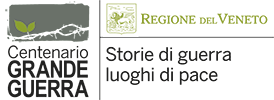- Luoghi da non perdere
-
 opere militari
opere militari -
 campi di battaglia
campi di battaglia -
 luoghi di comando e di retrovia
luoghi di comando e di retrovia -
 cimiteri, sacrari e monumenti
cimiteri, sacrari e monumenti -
 musei e raccolte
musei e raccolte -
 altri siti di interesse
altri siti di interesse
- Tutti i luoghi
-
 opere militari
opere militari -
 campi di battaglia
campi di battaglia -
 luoghi di comando e di retrovia
luoghi di comando e di retrovia -
 cimiteri, sacrari e monumenti
cimiteri, sacrari e monumenti -
 musei e raccolte
musei e raccolte -
 altri siti di interesse
altri siti di interesse
The last peak
Coming from Treviso, along the Feltrina, the great French War Memorial in Pederobba welcomes visitors. It was built in the Fascist period to recall the blood tribute paid by France to support the Italian front line after Caporetto. The Grappa range rises behind it. On the opposite side, the Cesen and you can see the Piave plain and the great bank of the Montello. Continuing west you must stop at the Gipsoteca of Canova in Possagno. The size of the Temple dominates the village; it was surrounded by Italian canons to control the Valcavasia in case the river front line collapsed. Inside the Gipsoteca (gallery of plaster casts), which was bombed, you can see the wounded casts by Canova, knowledgeably restored where possible. In the municipality of Paderno, locality San Liberale, which held a water lifting plant high up, you can see military shelters dug in the rock, also against gas, and the start of several military mule tracks. A cart road and paths, crossing third and fourth line trenches as you climb, can be taken in the locality S. Maria del Covolo, in Crespano del Grappa. An average capacity military cableway started from here. It was used to carry up provisions and munitions and carry down the dead and wounded. Villa Reale, in the historical centre of Crespano del Grappa, houses a document centre and a display of objects put together by a salvager. In Borso del Grappa and in Zen di Romano d'Ezzelino you take two really important military roads: the General Giardino and the General Cadorna. They were built as of 1916, following the lesson learnt from the Strafexpedition. Both roads are flanked, in some points, by military shelter caves and lead, joining at the end, to Cima Grappa. Having reached Ponte S. Lorenzo - point of maximum advance of the Austro-Hungarian troupes during the Battle of the Solstice - along the Cadorna you can turn towards S. Giovanni (which has, in a hotel, a small museum housing Grappa battle collections) to then reach the observation terrace over Valstagna. Cima Grappa has an extraordinary number of elements to be visited. The first is the Military War Memorial with the bodies of about 23,000 soldiers from both sides. The second site, entering through Caserma Milano, is the "Vittorio Emanuele III" tunnel, the biggest high mountain fortress of World War I, with about a hundred interception fire emplacements, built in 1918. Cima Grappa is connected to the north with the escape route from the Salaroli trenches, that accompany the road of the Val Vecia which, till a certain point, winds until Fontana Secca; it was controlled by the Austro-Germans at the time. There was fierce fighting here. To the east the connection to the summit trench of M. Boccaor. An impressive, suggestive route along the artificial raised border dug diagonally like a wound on the southern slope system of the mountain called "Sentiero delle Meatte". The descent towards east leads to the trenches (recovered) of Monte Palon and the battle sites on Monte Tomba, where there is a church dedicated to the French who fought alongside the Italians during the Battaglia d'Arresto rebutting the attack by Lieutenant Rommel. Back on the Feltrina, turning north you reach two sites of interest: the territorial historic Museum of the Town of Alano di Piave, with special attention for trench life, and the German Cemetery of Quero. If you turn south, the Sanctuary of the Madonna della Rocca in Cornuda is worth a visit; it was an Italian observation post of the Piave front line. Some trenches can still be read.
Source: Provincia di Treviso e ecomuseograndeguerra.it


 Dolomiti e area di Belluno
Dolomiti e area di Belluno  Altopiano di Asiago, Pasubio e area di Vicenza
Altopiano di Asiago, Pasubio e area di Vicenza  Grappa, Tomba, Montello, area di Treviso e Piave
Grappa, Tomba, Montello, area di Treviso e Piave  Venezia e Laguna
Venezia e Laguna  Baldo, Lessinia e area di Verona
Baldo, Lessinia e area di Verona  Area di Padova
Area di Padova  Area di Rovigo
Area di Rovigo  cerimonie
cerimonie  rievocazioni
rievocazioni  spettacoli
spettacoli  mostre
mostre  incontri
incontri  didattica
didattica  manifestazioni
manifestazioni  altro
altro  1915
1915 
 resta informato
resta informato download
download

